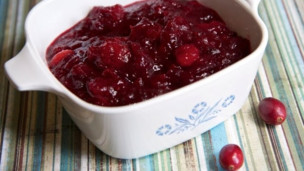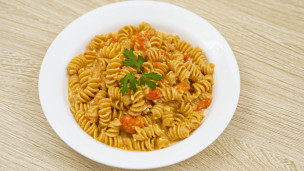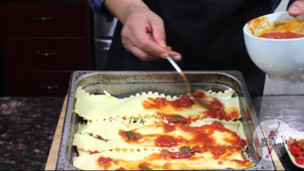Homemade Feta Cheese
(23:18)Cooking Recipe
Yields: 1 pound / 2 wheels
Cooking Time: 10 minutes
Prep Time: 90 minutes
Ready In: 1 hour & 40 minutes, 24 hour drain, 24 hour brine, and let it sit for 30 days
Ingredients:
1 gallon whole pasteurized milk or any milk of your choosing (Goat's milk is used in this video)
¼ teaspoon calcium chloride, diluted in ¼ cup water
¼ teaspoon MM100 mesophilic starter
½ teaspoon liquid rennet, diluted in ¼ cup water
1/3 cup salt
1 quart of water and 2 cups of that water heated.
Directions:
1. Make sure all your equipment is sanitized.
2. Pour the gallon of goats milk (you can use any milk as a substitute) into a medium pot from the edge to avoid splatter contamination.
3. Bring the milk to 70℉ over very low heat. Use the instant thermometer to check the temperature and stir gently with a slotted spatula till it rises to 70℉.
4. Once it's at the right temperature (70℉), sprinkle the 1/4 tsp starter culture. Evenly distribute it in the milk and let it sit for about 2 minutes so that the culture can start to absorb some moisture.
5. After about 2 minutes you should see some changes in texture now stir in an up and down motion for 30 seconds.
6. Now take the 1/4 tsp of calcium chloride and dissolve it in 1/4 cup of cool distilled water and pour the dissolved calcium chloride into the pot over the slotted spatula to distribute evenly. Stir gently which helps distributes the calcium chloride evenly. Let the mixture ripen at a maintained temperature of 70℉ for about an hour.
7. After an hour, take a larger pot or (bammery) fill it half way with water so that the bottom of the smaller pot can later be laid inside of it and rest on top of the water but not so much that it will overflow. Heat the larger pot of water to 100℉ temperature.
*We want to do this process because adding a 70℉ pot of milk on top off 100℉ water will balance itself out to 90℉. Which is the temperature we want.
8. When water temperature reaches 100℉ place the smaller pot containing the goats milk mixture on top, careful not to allow the hot water beneath to overflow into the smaller pot.
9. After about 5-10 minutes use your instant thermometer and check the temperature of the goats milk while you stir gently. Once it has reached the right temperature of 90℉ it's time to add the rennet.
10. In a bowl combine a 1/2 cup of cool water and add the 1/2 tsp rennet until dissolved. Use the stir spoon to evenly pour the rennet into the cheese mixture which is still sitting in the hot water bath. Stir gently to evenly distribute the rennet. Let it sit for about 45 minutes.
11. After 45 minutes use a long knife or cookie cutter to make a 2 inch incision, then pull the knife out, turn it, and at the bottom of the incision insert the knife at an angle and push up to see if the cheese is coming together well. You want the cheese to be solid, stable, and have a strong wall.
12. If everything looks ready, you can start to cut the cheese. Start from the edge of the pot and make half inch cuts lengthwise and then width wise to eventually make half inch cubes. Let it rest for 10 minutes.
13. After 10 minutes check the consistency of the curd. Give it a poke and if it maintains the shape your good to go. If it breaks apart let it sit for another 5 minutes. Stir the curds gently, more like folding the curds. This is the process to remove the moisture from the cheese. Continue for 15 minutes.
14. Now check once again by sampling a piece of the curd and poking it with your finger to ensure they have a stronger texture. If the curds feel more solid, stop stirring and let it sit again for another 10 minutes to allow the curd to sink to the bottom.
15. When all the curds have settled to the bottom and all you see is green whey on top, grab a strainer and rest it gently on top of the cheese and whey. Then using a ladle remove the whey that gathers in the strainer on top of the cheese that has now sunk to the bottom of the bowl.
16. Using a basket or a slotted spoon to scoop out your cheese curds to carefully fill a form halfway with curd. Don't fill it up to the top because they are still fragile and will be crushed.
17. Once you have filled the forms with all the curds, place the forms on a perforated pan on top of a stainless steel pan or just a simple bowl and colander to let the curd drain for 24 hours. But during the 24 hours you must flip the cheese regularly to get an even shape and even draining.
18. After about 4 hours of draining, the curd should have shrunken down to half its original size, and it is now time to flip it. Take your hand and rest it on top of the cheese then flip it out on to the palm of your hand and then flip it on to your other hand and flip it back into the form so that the side that was on the bottom is now on the top. Repeat this process every 4-8 hours for 24 hours.
19. After 24 hours your cheese is ready to be brined. Take 2 cups of water out of a quart of water and heat it up. Add in 1/3 cup of salt and stir until fully dissolved. Take the heated water with salt into the rest of the cold quart of water and place the cheese in a tray and pour the brine over the top of the cheese.
20. Use a needle point sheet to hold the cheese down into the brine and prevent the cheese from floating. Place a lid on the tray and let it sit in the refrigerator for 30 days. After 30 days take it out of the tray and place on to a plate and it is ready to eat! You can save the brine which is packed with flavor to be used at anytime so don't throw it away!
Serve with crackers, on salads or as part of a cheese tray.
Enjoy!

Testimonial



































